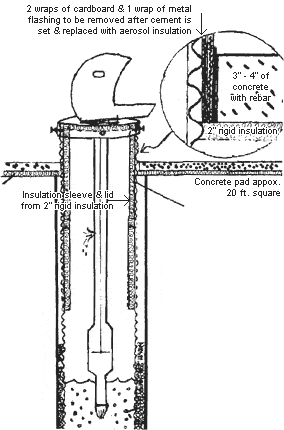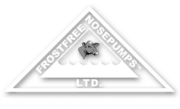Factors that protect your Frostfree Nosepump from Cold
- Geothermal heat rising inside from the ground– The depth of your culvert into the ground is an absolutely crucial factor in the heartiness of your system. We require your culvert be installed into the ground to a minimum depth of 21 feet for a steel culvert (or 18 feet for a poly culvert), and a minimum of a 24” in diameter. This will provide enough geothermal heat coming up from the bottom of your wet well to moderate the environment inside your wet well (combined with the other factors) no matter how cold the ambient temperature becomes (A 12 foot culvert is adequate if placing around an existing cased well). The specified depths can only be compromised for milder climate applications.
- Insulated wet well to hold the rising heat in and keep the cold out – By insulating the upper portion of the wet well and the underside of the lid, we not only keep the cold out, but hold the rising geothermal heat in. We require insulation of the inside of your culvert (for the top 8 feet), and the underside of the lid. Build two, 4′ insulation sleeves & 2 lids out of 2” closed cell rigid insulation (Instructions are provided with your FFNP(s)). One 4′ x 8′ sheet of 2” rigid will provide one 4′ sleeve and two lids for a 24” culvert. Be sure to caulk (caulking supplied with pump) between the hole in the lid, and the supply pipe to the hood, to prevent a draft causing heat loss
- Drain holes installed in supply line to allow water to seep away from the surface when pump is not in use – By allowing the supply line to drain away from the surface when the device is not in use, we actually eliminate any standing water in the top 5′ of the whole system when it is not in use. As such, there is NO water at the surface that could freeze during cold temperatures. Drill drain hole in the ABS 1½” pipe, 5′ down from the top of the culvert, & a second hole 5” down for spring or fall training (these holes are 7/64ths of an inch). One or both of the drain holes can be blocked during the introduction of the FFNP to your livestock TEMPERATURE PERMITTING to reduce the learning curve of your animals.
- Insulated concrete pad around the pump – We require an insulated pad to be installed around your FFNP. The pad will prevent livestock traffic from mining a hole around the pump and driving the frost zone deeper into the ground. By insulating under the pad, we create a frost break, which will actually diminish the frost in the ground around our wet well. A pad around your FFNP will also protect your water source from contamination. A 20′ x 20′ concrete pad with a 16′ x 16′ blanket of insulation (8 sheets of 4′ x 8′ closed cell rigid insulation) is recommended.
- Seal and frost break between the culvert and pad – To prevent the transfer of cold temperatures from the cement pad to the culvert, and to eliminate the possibility of contamination through this space, we must install a frost break between these two bodies. Use the frost break detail shown above to accomplish this. The aerosol expanding foam also helps create a water seal.
When ice build-up occurs on the hood in very cold weather (minus 25º C. and colder), a dead blow hammer should be used to shatter ice (comes with your FFNP). This will prevent damaging the powder coated finish. These factors must be adhered to strictly to ensure year round effectiveness of your Frostfree Nosepump!

Author: Jackie Anderson
